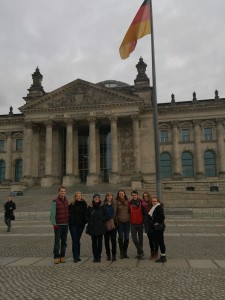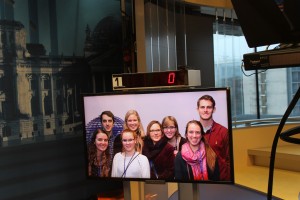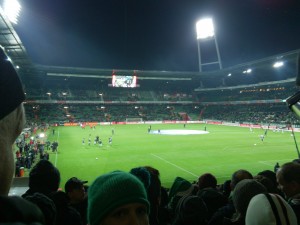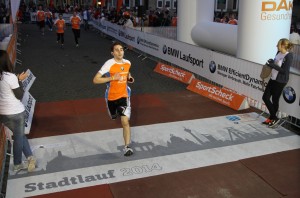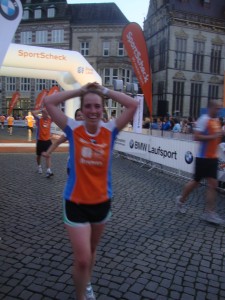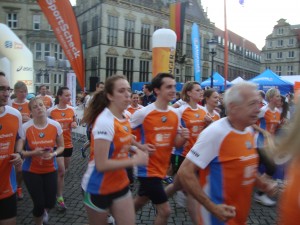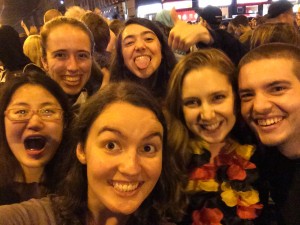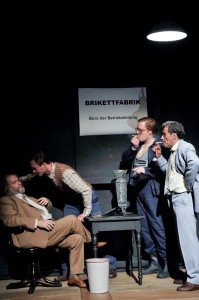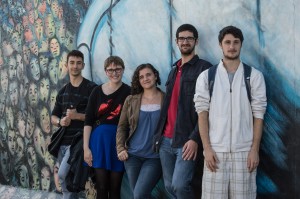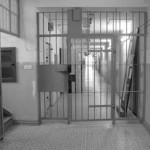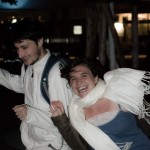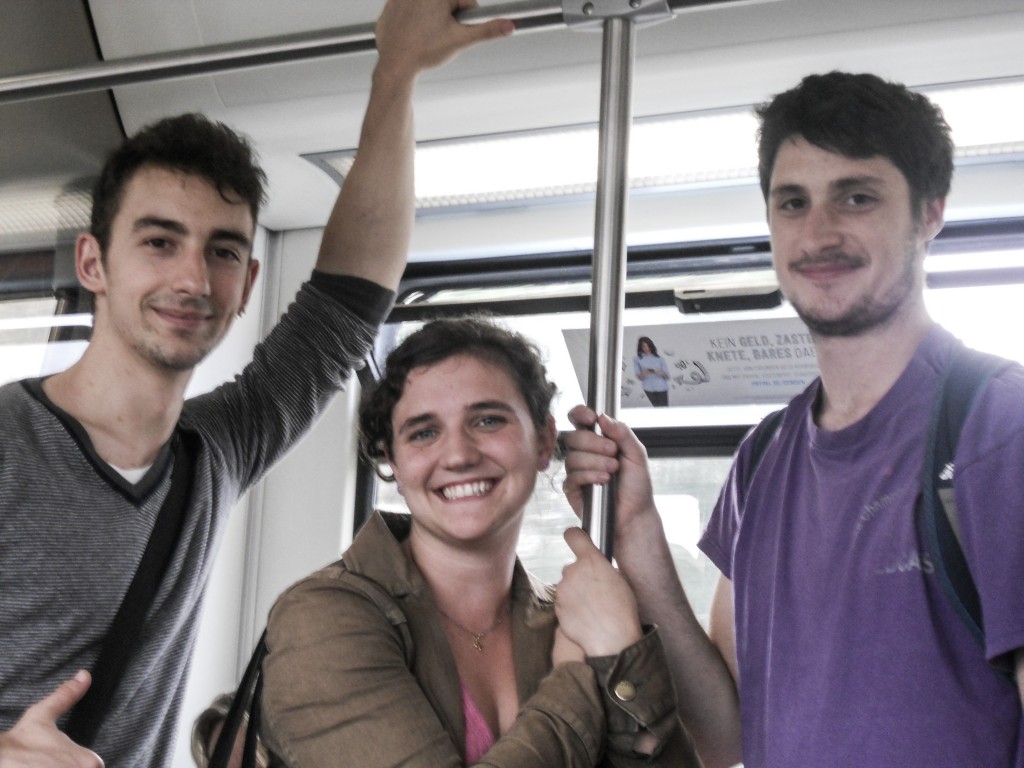Beer is a staple of any social gathering or meal in Germany but the way it is made is a mystery to many people. The Dickinson in Bremen program recently took a tour of the Beck’s Brewery right here in Bremen to discover more about this important and delicious drink. We first learned that Beck’s is not only the most popular beer here in Bremen but that it is also Germany’s largest export beer. It can be found in every corner of the globe. The next part of the tour took us through the process of beer production; from harvesting the hops to bottling and packaging the product. Finally, we were able to sample various types of beer produced at the Beck’s brewery. They had us guess whether the beer was Beck’s, Alcohol-free Beck’s, or Haake Beck, a beer produced by Beck’s but only served in Northern Germany. The Dickinson crew guessed correctly with only 4+ months of drinking Beck’s and Haake Beck under our belt. To our surprise, we were not rewarded with a lifetime supply of beer.
Beck’s Brewery Tour
Academic Differences Between Dickinson and Uni Bremen.
While studying abroad at a different university, definite differences are apparent. Before coming to Uni Bremen, I expected classes to be fairly similar to Dickinson but just larger. I soon came to realize that this was not the only difference. First, let me list all of the academic differences I have noticed between Uni Bremen and Dickinson and then I will explain each one:
1. The class size
2. The students ages
3. The “homework” and graded “assignments”
4. Semester time-frame
5. Grading system
6. The professors
The class size, at Dickinson, will not exceed 60 students and it is not uncommon for a class to have only 5 students. At Uni Bremen; however, the class size is much larger on average. To have a class with less than 20 students is not as common as having a class with 100+ students. My largest class had about 150 students. And on that note, this class of 150 or so students were composed of 4 students in their 20s and the rest of the students were over 70 years of age. To have older adults as students is not uncommon. Thirdly, the assignments for classes at Uni Bremen have a different expectation than those given at Dickinson. At Uni Bremen, the assignments given throughout the semester are typically readings listed on the syllabus. These readings will either be posted online or the student must go to a local bookstore. These readings are not mandatory, but an aid. If the class consists of discussion then reading the listed assignment(s) is recommended but again not mandatory like Dickinson. The actual graded assignments do not come until the end of the semester as one large grade. This one grade is what the student will receive for the class. This grade can either be a test, a project, an oral presentation, or a 10-15 page paper depending on the professor. As for the actual grades, they are not based off of a “A, B, C, D, F” system, but rather a point system. This point system is 1-5 in which a 1 is a perfect grade and a 5 is failing. The professors will be understanding to those who are international students, but it is very rare for professors at a German university, such as Uni Bremen, to know the names of the students. This is mainly due to the fact that most classes have over 50 students, but also because the student-professor relationship does not exist at Uni Bremen like it does at Dickinson. Another academic difference between Dickinson and Uni Bremen is attendance. Unless professors at Uni Bremen take attendance and make it an important issue to not miss classes, attendance is not taken as seriously as it is at Dickinson. Nevertheless, going to class is important!…but taken lightly by the majority of students. For one of my classes-that had no attendance requirement- there was a student who came to the last day to take the final exam…this student did not come to a single day of class throughout the semester. And lastly, as for the semester, the first semester (winter semester) begins late October/early November and ends in February as opposed to late August to December.
To those of you who find the differences to be intimidating, please do not be alarmed! These differences are very easy to adjust to ![]() .
.
Bremen-in-Dickinson
Vienna Excursion – Day 1
Our epic journey to Vienna started on Monday morning on the 5th of March. We met at the Hauptbahnhof in Bremen to make the hour and a half long trek by train to the Hamburger Airport. Flights are far cheaper from the bustling metropolis compared to our little provincial town of Bremen. The flight to Vienna was only about an hour and a half, and Air Berlin made our journey quite enjoyable feeding us delicious chocolates as we stepped down onto the welcoming soil of Vienna, Austria.
It took a short ride on the city-airport train and an even shorter taxi ride to get to our perfectly located hotel. Our hotel was on a side street by the State Opera House and right at the end of the main shopping street. It was close to the Ringstrasse which is the circular street surrounding the inner city of Vienna.
After we arrived in the late afternoon/early evening, we had a chance to settle in before we headed out for dinner at the Zwölf- Apostelkeller, a slightly kitschy, but nevertheless nice restaurant. The menu offered many different kinds of heavy meat and potatoes type meals, such as Schnitzel or Saftgulasch (chunks of meat with lots of sauce) with potatoes, just like any Heuriger (traditional Viennese restaurants) on the outskirts of Vienna would.
The restaurant was in the basement of a building (hence it being called Keller) and was very beautifully decorated. To make the evening all the more enjoyable there were musicians, a violinist and an accordion player. These two men played throughout the evening and even stopped by our table and took some requests, even humoring us by playing “Edelweiss”. I of course took the opportunity to shamelessly sing along; we were in Vienna after all, the city of music, and I just couldn’t help myself.
After dinner we all decided to stop at Zanoni and Zanoni, THE Ice cream place in Vienna. They have all kinds of ice cream, gelato, soy milk ice cream and even something called Milk Rice Ice Cream, which is actually quite delicious. It was a tad bit cold for frozen treats, but nevertheless it was incredibly delicious and that does tend to be what Germans do anyway: eat ice cream in winter. We then headed home for an early night, as we had an absurdly full week ahead of us.
Vienna Excursion – Day 2
We all anticipated today, our first full day of sightseeing and touring the city. The day started early with an awesome breakfast spread at the hotel consisting of bread, cheese, and meat, but, most importantly, a personal pot of coffee. Satisfied and energized from breakfast we set off to meet our tour guide outside of the Albertina Museum. It was a beautiful morning and with sunshine greeting our anxious, glowing faces we started off on our tour. The tour could not have been neater; it provided us with a dose of historical background to the stunning buildings around each corner. I had a tough time keeping my mouth closed on the tour as we went from building to building, shocked by the beauty of the city.
The tour gave us just a glimpse of the city, so after lunch we were ready to delve deeper into a historical site. We started off big with St. Stephen’s Cathedral. The Romanesque and Gothic architecture made the whole cathedral seem surreal. Everything was ornate and had such detail that it just did not look real. However, the cathedral offered more than just its architecture. It had a rich, long history, part of which it literally still had in its depths: the catacombs. We were lucky enough to get a tour of the catacombs, where the remains of past Viennese continued to rest. I will not lie. It was a little creepy. Anyway, it capped off a great first day that left us in awe of Vienna.




Vienna excursion – Day 3
Today was our 3rd day in Vienna and I really must admit that it is probably the most beautiful city I have visited. Every street I walk down, I sense the coexistence of history, poshness, and nonetheless extreme livability. Today our activities included the more historical and political facets of Austria’s capitol city. First we went on a very in depth tour of the Austrian National Library. Located in the Hofburg palace, I would hardly say this library was comparable to Waidner-Spahr. It was ornate and filled with numerous original prints, such as Martin Luther’s bible. Three hours and a passionate tour guide later, the group was on to our next tour, this time of Parliament. The tour gave an informative insight into the government of a once powerhouse country. With my free time afterwards, I ventured into another part of the city to find the house of none other than Sigmund Freud. As the daughter of two clinical psychologists, it was truly exciting just walking through Freud’s residence, where he lived until 1938 when he was forced to flee to London due to his Jewish ancestry. Vienna has really surpassed my expectations and even in a tightly packed week of tours, meals, and museums, there is so much more I hope to experience during another visit in the future.




Vienna Excursion – Day 4
On Thursday morning we awoke to a little surprise, snow! After having had several days of sunshine, Vienna decided it was time to throw something a little more interesting our way. We marched out into the light snowfall and on to the Mozart house. The Mozart House is located a street or two away from St. Stephen’s Cathedral and is actually an apartment in which Wolfgang Amadeus Mozart, along with his wife and children, lived for several years. The entire building has been converted into a museum, but the main exhibition is located in Mozart’s apartment.
There are some original pieces, such as some furniture, letters and sheet music, but the majority of the museum consists of information about Mozart’s compositions and life. The walls are covered with information, there are display cases in every room, and everywhere you turn there is something to be read. The audio guided tour addressed everything from Mozart’s childhood to his death and every little detail about what happened in between. We had no problem spending several hours there, despite the relatively small size of the museum. This was my third visit to the Mozart House and still I managed to be one of the last ones finished.
After our Mozart overload we headed off for lunch at a restaurant that only serves dishes containing potatoes, apples or both. Even their decoration was centered on the two ingredients. With such limitations one might think there weren’t very many choices, but that was certainly not the case. Everything was delicious and innovative. It was clear that this restaurant was a lunchtime hot spot, as after a little while the place was completely full.
In the afternoon the majority of us went on the tour of the Opera House or Staatsoper. The Opera House is one of the most significant places in Vienna. Many famous singers, composers and musicians have graced audiences with their music in that building. Every year the Opera Ball is held there, which is the most important event on the social calendar, so much so that it is televised. Vienna is the city of music and the Opera House is a center for that music. It has been open for hundreds of years and is one of the most, if not the most, famous opera houses in the world. The tour was quite short, but we were taken through the main staircase, reception halls and the main house. The building is decorated with flamboyant baroque architecture and ornate artwork, except for several more modern, but equally rich rooms, due to destruction during World War II. The Staatsoper is a “must see” on any tourist’s list when going to Vienna, but what makes it even better is to actually see a production there, which we unfortunately were unable to do.
Later in the evening we all met up at Café Demel, which is one of the most famous of Vienna’s coffee houses. Demel is famous for creating delicious and original treats for the Empress Elizabeth. They continue this tradition and we were lucky enough to enjoy some of their scrumptious delicacies.
After our indulgent trip to Café Demel we attended a production of Brecht’s The Threepenny Opera at the Volkstheater. The building itself is very beautiful, being richly decorated in the Baroque style, but the production was very commanding of the audience’s attention. The actors, musicians, lighting and set were fabulous. I found myself fully captivated by what was taking place on stage. It was one of my most successful and enjoyable trips to the theater, and I have had many.
After watching an incredible performance, what better to do than grab a drink at a rooftop bar? This is exactly what we did. Around the corner from the Volkstheater is a hotel with a new bar, Dachboden, on its roof, providing its visitors with a fabulous view of Vienna. Dachboden is very popular and was quite full, but it was still the perfect way to end the evening, looking out on one of the most culturally rich, glamorous cities in the world.
Vienna excursion – Day 5
On Friday, we discovered more about the wealth and imperial power of the Habsburg dynasty. The day started with a tour of the Schatzkammer, the imperial treasury. Over the course of hundreds of years, the Habsburg family accumulated many precious and valuable items and now the Schatzkammer displays those items to the public. Items on display include the Imperial Crown of Austria, the treasury of the Order of the Golden Fleece, and the Burgundian Treasury. For the Habsburgs and many other imperial families, jewels were a way to display wealth and power. Another way the Habsburgs showed their status was with grand palaces.
On Friday evening, the Dickinson group visited the Schönbrunn Palace which included a tour of the main building, a traditional Viennese dinner, and a concert consisting of the music of Mozart and Strauss. The Palace was the summer home of the Habsburgs but is located just outside of the center of Vienna (a short 15-minute ride by tram). The elegance of the rooms and expanse of the property truly reflect the wealth and power of a family that ruled Central Europe until the crushing defeat of their empire in World War I. Today, Austria is a small nation with limited global scope. The Schatzkammer and Schönbrunn Palace are reminders of how powerful the nation once was and the changing status of nations in global power politics.




Vienna Excursion – Day 6
On our last day in Vienna we went out with a bang. We started Saturday morning with a trip to the twin museums. The Kunsthistorisches Museum (art gallery) and The Naturhistorisches Museum (natural history museum) are two enormous buildings situated directly across from one other, with the statue of Empress Maria Theresia between them.
I have visited both of the museums as a child and find them both to be phenomenal. The museums are full of fascinating objects and are a “must see” when visiting Vienna, however, a lot of time needs to be allotted to those visits. This time I decided to go to the Kunsthistorisches Museum, my favorite of the two. This art gallery starts with Egypt and on three floors continues throughout history, ending with a special exhibition on the top floor, which was an exhibition of clothing made by students at Vienna’s fashion school. I had a little over three hours in which to see the museum, and I can honestly say that I needed more time. I read almost none of the little plaques stationed by each work and continued through at my steady museum stroll. I was impressed by how extensive the Egyptian and Greek sections are. The museum holds works of artists such as Velázquez, Raffaello, Caravaggio, Bosch, Rubens, Rembrandt, Vermeer, Dürer and Gainsborough. However, my favorite work is a small blue hippopotamus decorated with lotus flowers and birds found in the Egyptian section.
After our museum excursion we went on to lunch at Centimeter where I had a delicious Schnitzel with French fries. I think it’s safe to say it was so delicious and huge that I felt slightly ill afterwards. Feeling satisfied and stuffed, we went back to the hotel to collect our luggage and fly back to Bremen. As hard as it was to leave one of my favorite cities on earth, I know I’ll be back again. And at least I had the delicious chocolate from Air Berlin to look forward to.
Berlin Excursion
Bienvenue in Berlin
(Janie Feldmann ‘15)
To be honest, if you are going to a city for the beauty, you should not go to Berlin. This city is by no definition beautiful – it is grungy, grey, and graffiti-filled. But Berlin has some of the coolest history of any city, and it is just all around cool. There is something new around every corner, and the art scene is fantastic. It reminded me quite a lot of New York City.
Our schedule was quite packed, but we had the opportunity to see some really great sights. Among these were the Reichstag government building and East Side Gallery. We went up in the “Dom” of the Reichstag at night, so we had some spectacular views of lit-up Berlin. And at East Side Gallery, we had the amazing experience of seeing what remains of the wall which formerly divided this city and its people.
In our free time, my roommate and I decided to go to the Pergamon Museum, which is located in the heart of the city on the Museum Island. Unfortunately, tickets were sold out, so we decided to go to the DDR Museum instead. This museum displays various objects from daily life in East Berlin. It even showed a car and an example of a living room, which were both really interesting. With all that we had learned about apartment bugging and phone tapping, it was easy to forget that people just like us had to live their everyday lives during this time.
My favorite things we saw were the Holocaust Memorial, a performance of Spring Awakening, and Hohenschönhausen Stasi Prison. The memorial is incredibly hard to describe – you truly have to go there to get the full experience. At first glance, you can only see the tops of the grey stones as you walk in between the rows. But as the ground sinks slowly, the stones grow, and all of a sudden they completely surround you. They seem to stretch on endlessly – you could honestly lose someone in there. Because the aisle is only wide enough for one person, you often have to turn away when another person is coming from the opposite direction. The experience of this monument was unexpectedly unnerving, and it was probably the most well-done memorial I have ever seen.
The dance performance of Spring Awakening took place in a small theater called Ufa Fabrik, which was formerly used as a factory. I will not lie, I was not sure what to expect, but I was truly amazed by the level of skill that the dancers displayed. The performance was so emotional and beautiful, and we all left with goose bumps.
However, Hohenschönhausen Stasi Prison was by far one of the most affecting experiences I have ever had. We had the honor of taking a tour with a man who had been arrested three times by the Stasi, and placed in a prison in Potsdam. He told us calmly of the horrors he had endured, and explained that he only felt pity for the men who had done these awful things to him. I bought a copy of his book and he signed it “Nie wieder Diktatur” or “Never again a dictatorship.” I do not think I will ever forget him, or his experiences.
In the end, I truly believe that going to Berlin for the beauty would be overlooking what makes this city so special. Berlin has so much more to offer than just vain aestheticism – edginess, determination to never forget, or repeat, its past, and strength to move forward into the future.
Werder Bremen
(Janie Feldmann ‘15)
On Sunday evening (Nov. 24, 2013), the Dickinson in Bremen program took us all to see a Werder Bremen soccer game at the Weser Stadium. I am definitely not the person to ask if you want to understand how soccer works – the only fact I know for sure is that one team scores in the other team’s goal. (I know, I know, I’m the worst German-American ever). Despite this, I discovered that there is something universally nostalgic about going to a live game and rooting for the team you love.
As expected, the tram was jam-packed with people going to support Werder, which, to put it nicely, is sort of the underdog in the German soccer league. We were in the standing-room-only section, which was actually very cool because for one, it was warmer, and two, the atmosphere was very excited. One of the best moments of the game happened after the players came out onto the field: Werder fans began singing the official song of the team. The first line is “Werder Bremen, lebenslang grün-weiß!” which translates to “Werder Bremen, life-long green and white!” We had all learned the song before the game, and I do not think a single fan was not singing – it was such a great moment. Everyone held up their Werder scarves, and the camaraderie was absolutely fantastic.
The excitement soon became frustration, however, as Mainz scored two goals during the first forty-five minutes, and Bremen just did not seem to have any luck. After half-time, Mainz scored yet another goal, and everyone started feeling pretty hopeless. I thought it was pretty impressive that the majority of fans stayed until the bitter end instead of leaving to beat the traffic. Staying was worth it though – in an exciting change of luck, Werder scored not one but two goals within the last fifteen minutes! Everyone was hoping that they would make one more to even out the score, but sadly that was not the case. Despite this, everyone was going out of their minds with happy excitement, singing song after song. I personally thought it was awesome that for every goal Werder scored, the stadium played “I’m Gonna Be (500 Miles)” by The Proclaimers.
Admittedly, I have always had a bit of trouble (perhaps because I am an English major) understanding the importance of sports. I never really get why people go so crazy over them, and I definitely do not understand the mindset of die-hard fans. But, at this game, I felt I began to get a grasp of why soccer is so important within German culture. After a war which left the world speechless, cities in ruins, and people desperate for change, soccer became the means through which Germans could begin to heal. They may still have trouble feeling proud to be German, but they are definitely proud of their cities, and especially their soccer teams. Through all the disunity happening around them, soccer was the one thing where everyone could feel united again. And, if nothing else, there is really no better feeling than being in a stadium rooting alongside other fans, even for an underdog team.
East Side Gallery
Joan Smedinghoff ’15
“I painted over the wall of shame so freedom is ashamed no more. Inferno ruled too many years, until the people chose the light. I put my faith in you, Berlin, and give to you my colors bright.” - Fulvio Pinna
On our second day in Berlin we went to the East Side Gallery, which is a section of the Berlin wall that was left up and artists have painted murals on it’s eastern side. It’s spectacular and stretches on for a few blocks. There were many different kinds of murals — some with beautiful scenes, some with messages of peace and togetherness, and some about Germany’s past or future. They were so intriguing that I found myself stopping and taking pictures at almost every mural.
One of the things I found myself thinking a lot about was the difference between pictures take from the western and eastern sides of the wall. In pictures from West Berlin, the wall is covered top to bottom in graffiti. In East Berlin, though, people were not allowed to come near the wall, so it stayed barren. In West Berlin people graffitied everything from their initials to anti-communist slogans, but the people of East Berlin did not have that outlet to express their frustrations because it, like so much else, was cut off from them.
After reunification, the East Side Gallery finally became a place for people to paint their images of protest and peace. The Berlin Wall represents a difficult time of separation in German history, and those two very different pictures of the graffitied and barren sides of the wall represent the the free speech that was lost in East Germany. However, I think that the East Side Gallery now stands as a representation of that free speech being given back to the people of eastern Germany.
Bremer Nachtlauf
On May 23, nine of the ten current Dickinson-in-Bremen students decided to form a team together with Verena and former Dickinsonian Julie King (Class of 2012) to run a 5K through Bremen’s city center. Read here, what some of the students had to say about the run.
Devon:
The Bremer Nachtlauf was my first 5k or any sort of running event of any sort, but it certainly proved to be a lot of fun. I saw parts of the city I never had and a very certain ethos from those around me. I felt very together with the other racers, and while we weren’t running for any cause other than fun, it certainly made me feel like I belonged.
Anna:
Running together in the Nachtlauf was really fun. Even though I’ve been here for 7 months, I still discovered a few new parts of Bremen on the run!
Margaret:
The Bremer Nachtlauf was the first time I’ve ever run a 5K, and I simply couldn’t have imagined a better experience! The start/finish line was located right in the magnificent city center, directly before the Town Hall and St. Petri Dom Cathedral, and the route of the run took us through the city center streets and directly along the banks of the Weser river. It was a wonderful experience I won’t soon forget to run that great route with people lining the streets and cheering us on. Definitely a highlight from this semester abroad in Bremen!
Shuwei:
“Stadtlauf” in Bremen is really about people, males and females, young and old, all getting together and enjoy sport. The running itself is therefore very enjoyable, the music, the atmosphere, and the beautiful scenery over Weser river along the way. It’s definitely one of the most unforgettable experiences I’ve had here in Bremen.
Joan:
I’m so happy to have taken part in the Nachtlauf. It was great running through Bremen with everyone and having people cheer us on!
Danette:
I was a bit apprehensive when I decided to sign up for this 5K as I hate running, but I wasn’t going to cave on the motto of my year abroad: “Do not say no to anything within reason”. Certainly, a 5K was within reason and so I had to say yes. I really do hate running, I get bored quickly and my thoughts tend to wander, but I talked with Joan and since we were in about the same physical condition we decided to run the race together. It was great having someone to run with since we were able to chat and keep each other company. I will admit, I complained a bit (well a lot) before the race and probably during, I’m not sure you’d have to ask Joan. But I am so glad I ran it. It was a great sense of accomplishment and I can finally check running a 5K off my bucket list.
Janie:
On May 23, the Dickinson in Bremen students completed the “City Run” through the streets of Bremen. Although I really enjoy running and used to run cross country, I was actually a bit nervous: this 5K run was my first “official” 5K run and I had only trained very minimally for it. Despite that, before the run began, the atmosphere in the city was really exciting and the weather was perfect. During the run, I almost had to stop twice due to my asthma. But I did not give up and instead ran the entire time! My time of completion was around 32 minutes – I was really proud of myself. After the run there were apples, bananas, juice, and beer for all participants, for which I was very grateful. It was really fun to run with the other Dickinsonians as a “team” and I would definitely recommend this event to the future Dickinsonians who will study in Bremen.
Sean:
The Bremen Nachtlauf was a great treat, especially considering I hadn’t run a proper race in nearly 5 years. Despite my long hiatus, I was pleased with my overall performance – at roughly 24:30, the time was not my best but also far from my worst. I was also shocked at how stereotypically German the event was. At the finish line we were given not only the usual fresh fruit and water, but also beer and Apfelschorle, two immensely German staples. Overall it was an amazingly rewarding and fun experience.
World Cup 2014
Relive Germany winning the World Cup by reading the following statements by this year’s Dickinson-in-Bremen students as well as Prof. McGaughey, who was in Germany during the World Cup as well, along with her recap of our excursion to Hamburg and Lübeck. (Visit our Facebook page for additional video footage: Dickinson-in-Bremen on FB!)
Joan:
I’m so happy I got to be in Germany for the World Cup — and feel so lucky to have seen them win too! The atmosphere in the city after each game was incredible, and only built as Germany advanced further. My favorite part would probably be after the games, when people would gather at one of the intersections in Viertel and just celebrate in the streets. Most of the time people would completely block the intersection with celebrating, chanting, and dancing. I had so much fun during the weeks of the World Cup and will never forget this experience.
Devon:
I knew throughout my trip to Germany that I was experiencing something unique and very much special; to be able to have watched my host country win the World Cup while here was simply the icing on the cake. While I was separated from the rest of the group, being in a crowded bar as the cheers erupted was truly sobering.
Shuwei:
We are certainly the lucky ones. After twenty-four years Germany became the World-Cup Champion again and we are here to experience all the stress, excitement and ecstasy. We celebrated on streets, danced and sang loud, and had high fives with people passing by. What a memorable experience! Cheers Germany!
Sean:
The World Cup excitement in Bremen was absolutely incredible once the Finale rolled around. I went to one of the larger public viewings in Bremen, despite the forecast of rain. By the time Mario Götze made the defining goal, we were all standing in a complete downpour. Not even rain could kill the mood after Germany won the World Cup. Hundreds of people quickly took to the streets and celebrated in the main intersection of Das Viertel and remained there until the early hours of the morning. It was one of the most memorable experiences of my year abroad. Deutschland ist Weltmeister!
Anna:
Even when the WM games were on weekday nights — whether at 6pm or midnight — the bars were packed and we would show up hours early (literally, three hours early to save seats for the final). The energy was just amazing and somehow got more intense every game, everyone on the edges of their seats (or standing) the whole time and alternatively gasping, leaning forward, cheering and jumping up and down in unison. And then when Germany won in the Finals, we were in Viertel, singing and dancing in the streets all night. It’s definitely an experience I’ll never forget!
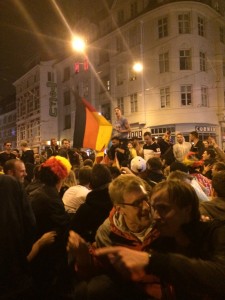 Margaret:
Margaret:
I’m still in disbelief over how lucky I was to be in Germany during the World Cup this year. Experiencing Germany’s victory was something I’ll never forget. I watched the final game with a group of other Dickinson students at a public viewing at a bar, where together we suffered through the seemingly-eternal nailbiter 0-0 score (and overtime! It really got rough…) before finally seeing Germany sink the winning goal shortly before overtime ran out, and jump to our feet cheering and hugging along with the rest of the crowd. When the game ended, we already knew the streets would be filled with people and the city basically shut down, but outside was even more insanity (and fun) than we could have expected. In the heart of the younger Viertel section of the city, the streets and sidewalks were filled so much we could barely walk, our ears rang from the fireworks being set off directly over our heads (or sometimes on sidewalks), and we got used to random people hugging, high-fiving us, or just yelling “DEUTSCHLAND!” or “WELTMEISTER!” in our faces. By 3 AM, we had joined the section of the crowd dancing to music being blasted from one of the overlooking apartments. There were block-long conga lines, instances of everyone putting their arms over each other’s shoulders and just happily swaying to the slower songs, and of course at least three separate heartfelt renditions of Queen’s We Are The Champions. I had a sore throat from yelling, sore feet from dancing in the street, and ringing ears from the fireworks, but I wouldn’t have traded that once-in-a-lifetime experience for anything.
Danette:
I had the good fortune of being able to watch the World Cup with several of my close German friends. They invited Janie and I over for the game to drink and watch. We were all decked out in fan gear with our faces painted with German flags and a German flag around our shoulders. As a huge football fan myself, this was the ultimate game for me. I watched breathlessly as the game ended in regular time at 0-0, and I think I was praying to every religious figure I could think of that Germany would win this game. Sadly our screen was delayed by about 2 minutes but I could hear cheers erupting around the neighborhood we were in, so I knew something good had happened. Then I watched Mario Götze receive the ball and volley it into the back of the net, I believe I almost cried because of how happy I was. There was still time left to play and never have I been so tense watching a game, I think I almost broke the chair handles because I was clenching them so hard. But then the whistle sounded and the game was over, GERMANY HAD WON. Janie and I knew that we needed to get into the city and quickly to have a great celebration with our friends; we boarded the next tram into the city and we hopped off at the Hauptbahnof. What a party it was. Trams and buses had stopped moving because they couldn’t get through the throngs of people, there were fireworks going off, people everywhere were yelling, chanting, dancing and cheering at the top of their lungs. It was insane. We made our way from Hauptbahnof to the Viertel and the party was even bigger. People were dancing in the streets, throwing beer around, and waving flags. It was an amazing experience to be a part of and something I will never forget.
Janie:
The night of the World Cup was, for me, absolutely unforgettable, and was one of my favorite memories of being in Germany. Danette and I watched the game at a close friend of ours, along with some other German friends. Naturally, we were all decked out in black, red, and gold to support the German national team. For some reason, probably because so many others were streaming the game online, there were delays, and we soon were a few minutes behind. We heard cheers outside, but still were not sure – and then Götze scored, and we all just yelled at the top of our lungs in pure joy. Then, the night got even better because Germany won, and it just truly felt like such a once-in-a-lifetime experience – being in Germany for the once-every-four-years cup, and then Germany won! Danette and I decided to continue the celebration outside, and went to the central train station. Absolute madness was ensuing there, with fireworks, and endless chants. From there, we walked to the “alternative quarter,” where it seemed like the entire population of Bremen had congregated. Everyone was out of their minds cheering, dancing, singing, and drinking, and there was a really awesome sense of friendly camaraderie. Even though we had to walk all the way home (about an hour and forty-five minutes), it was all so worth it, and it is definitely an experience I will never forget.
Prof. McGaughey:
Distraction.
In the midst of a World Cup summer all activity that was not associated with soccer could be categorized under distraction. Distraction is what happened between games. In that time when you were waiting until the moment when you could reload the soccer site again and again with the hope of learning the lineup of the next game. Distraction was hard to come by, however. So much of the summer in Germany was about the World Cup. There were reports of the overpriced, island retreat of the German team in Brasil, the expensive stadiums, the corruption within FIFA, and the corruption and violence FIFA and soccer initiated in Brasil and throughout the world. And then there were the constant updates of the health of the team – could Schweinsteiger play? Was Hummels sick? The news was saturated with soccer scores and analyses and towns were full of public viewing sites, pulsing with conversations about the teams and the tournament. For games, the Germans sat or stood and watched ARD or ZDF – the two public channels – and heard passionate commentaries from former soccer stars Mehmet Scholl and Olli Kahn. Even during the advertising breaks, Pep Guardiola assured us that German engineering (or soccer?) was about innovation and “Vorsprung.” As the tournament went on and Germany continued to win (OMG, that historic game against Brazil!), the continuous presence of soccer in daily life became more difficult to take. Thus, my move from Tübingen to Bremen came at just the right time. Time to say “Moin” instead of “Gruß Gott” and time to see all of the Dickinsonians in Bremen. Even better, Verena had organized a short trip of two days and one night in the Hansestädte of Lübeck and Hamburg. We learned how to model mice and hearts out of marzipan and read about the tragedies and literary successes of the Mann family. We had a delicious dinner (fish, of course!) on the Inner Alster Lake on a boat (On a boat!) and wandered through the Fischmarkt on Sunday morning. We spent hours watching amazing moving miniature replicas of Switzerland, Austria, and Middle Germany and studied the miniature representations of party platforms from the last two elections. We drank excellent coffee. We spent an hour and a half moving blindly through daily spaces at Dialog im Dunkeln (Dialogue in the Dark). It was a fabulous trip. As the weekend trip came to a close and the second major soccer game of my lifetime approached, this all became distraction. Despite attempts to not discuss the game or soccer (there was a pact involved; it was agreed upon), the real focus was the game. Where were we going to watch it? Should we bring our backpacks home or just go straight to the Lagerhaus and take our seats? Arriving in Bremen only an hour and a half before the game began was taking a risk. We were late. Where do we find seats? Luckily, Joan had saved seats. Under a roof. At first, seemingly unnecessary, but after a huge storm hit mid-game, the (relatively) dry Dickinsonians were all the more thankful for Joan’s efforts. For all the focus on keeping ourselves distracted, I can’t tell you much about the game. It was fascinating and compelling, nerve-wracking and horrific (I mean, why wasn’t there a goal in the first half?!). But it all became a blur, when The Roar happened. Most people don’t call it “The Roar”. Most people refer to it as the goal made by Mario Götze in the 113th minute (yes, that’s overtime, if you don’t know soccer). But the lived experience I now call “The Roar.” I couldn’t even hear myself screaming as I jumped up from my seat. And the roar was not just a moment; it repeated itself as the goal was replayed and everyone hugged one another. Only after the third or fourth replay did the roar become a rather large cheer. And then the cheering happened. The crowd, thousands of miles away from the game, wanted the German team to hold their ground. And so they cheered. The last minutes of the game became a resounding repetition of “Deutschland, Deutschland.” And then we won. The game was over. And we sang “Oh, wie schön” perhaps best translated as “Oh, how wonderful”. “Such a beautiful thing,” we all sang, “we had not seen in a long time.” A long time. And it was beautiful. Manuel Neuer told us we were world champions. And to celebrate we watched the ceremony and headed out onto the streets to celebrate more.
Berlin Excursion – Deutsches Theater
Theater Play Die Sorgen und die Macht (The Sorrows and the Power)
A play by Peter Hacks (world premiere: 1959), director: Tom Kühnel, Jürgen Kuttner (premiere: Sep. 4, 2010)
The first night we were in Berlin we went to the Deutsches Theater to see “Die Sorgen und die Macht” (The Sorrows and the Power) – a special showing to commemorate the 25-year anniversary of the fall of the wall. It was interesting enough to be in a German theater, but it was especially exciting to see Jürgen Kuttner on stage after having talked to him in my German class last year. The play itself was a bit difficult for us to understand because it was frequently referring to German history which I’ve been learning over and over we aren’t really taught in school. That being said, I definitely learned something and enjoyed the performance.
<Katie Mooradian ‘16>

© Arno Declair. Fr. l. t. r.: Claudia Eisinger, Felix Goeser (with Pittiplatsch mask), Susanne Wolff
It was especially cool because the co-director, Jürgen Kuttner, had previously come to Dickinson and he was also a part of the play. Politics are not the most interesting thing to me so there were some parts of the play that went over my head in that aspect, but there were many comedic parts of the play that I really enjoyed, and it’s always confidence boosting to understand a performance in a different language. <Cassie Blyer ’16>
The show dealt with the conflicted feelings East Germans faced during the start of the new communist regime. The show contained advanced German and references to specific points and things in history that I did not understand, however the show itself was portrayed in such a way as to convey the mixture of readily accepting any non-fascist government and doubts about communism understandable to any audience member. <Rachel Schilling ‘16>
Berlin Excursion – East Side Gallery
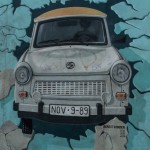 The East-Side-Gallery is not only the longest remaining piece of the Berlin Wall but also the largest open-air gallery in the world. I was able to visit the East-Side-Gallery on October 3rd, Germany’s Unity Day, a national public holiday that celebrates Germany’s reunification in 1990. This was certainly more surreal than the town’s center and although probably imagined, there was a palpable tension still hanging in the air once you stepped over on to the east side. <George DeRosa ‘16>
The East-Side-Gallery is not only the longest remaining piece of the Berlin Wall but also the largest open-air gallery in the world. I was able to visit the East-Side-Gallery on October 3rd, Germany’s Unity Day, a national public holiday that celebrates Germany’s reunification in 1990. This was certainly more surreal than the town’s center and although probably imagined, there was a palpable tension still hanging in the air once you stepped over on to the east side. <George DeRosa ‘16>
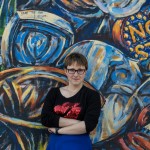
My favorite cultural activity was the East Side Gallery. […] Each artwork has a deeper meaning about freedom, reunification, and what it meant for the artist to live through the fall of the Berlin wall. As an art enthusiast I really enjoyed looking at these pieces and I feel a sense of luck that I have had that opportunity now, before they are all completely destroyed. It is rather sad that the works have not been preserved like normal artworks. They are a free museum and out in the open, therefore many people have decided to add their own “master pieces” to this great work of art. I was very annoyed to see many preteen girls writing cliché things on the wall such as “peace and love” or “Allie and Johnny forever!”. Hopefully, the work lives on to inspire many other people like it has inspired me. <Adrienne Brown ‘16>
While there were beautiful murals painted on the wall, many were covered in fresh graffiti and people’s names. This mix of old artwork and new graffiti made me think about the meaning the wall might hold for those who, like me, were born within a few years after the destruction of the wall. <Rachel Schilling ‘16>
I was disappointed to see that so many more people had written their name on the monument, but was glad that they do clean them every so often. I really love the idea behind the monument, to take this symbol of war and after it’s served its use, hire artists famous at the moment from all over the world and give them free reign to create what they want. Not only does it help the city, but also gives the artists exposure. <Katie Mooradian ‘16>
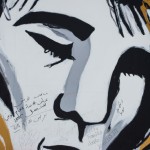 Katie and I found this on accident trying to find our way to a flea market at the Ostbahnhof. I’m very happy we did because it was one of my favorite parts of the trip. I love the different paintings on each section of the wall, however I did not enjoy the graffiti all over the art. I do advocate street art, but a teenager writing their name in the middle of a beautiful painting for no reason other than “to have their name on the Berlin Wall” is ridiculous. Other than that, I could’ve spent hours looking at every piece of that decorated wall. <Cassie Blyler ‘16>
Katie and I found this on accident trying to find our way to a flea market at the Ostbahnhof. I’m very happy we did because it was one of my favorite parts of the trip. I love the different paintings on each section of the wall, however I did not enjoy the graffiti all over the art. I do advocate street art, but a teenager writing their name in the middle of a beautiful painting for no reason other than “to have their name on the Berlin Wall” is ridiculous. Other than that, I could’ve spent hours looking at every piece of that decorated wall. <Cassie Blyler ‘16>
Berlin Excursion – STASI Prison in Berlin-Hohenschönhausen
On the last day of our trip a few of us went and toured the prison in which the GDR police placed citizens that posed a threat to communism. Our guide, who was once a prisoner here himself, reminded us throughout the tour that these buildings aren’t a recreation meant for us to observe and scare us, but instead these cells were used to hold thousands of inmates in horrible conditions. The prison was not only very eerie but extremely eye-opening. <Rachel Schilling ‘16>
We almost didn’t make it here because it’s out of the city and we got lost both trying to find it and trying to get back, but it was absolutely worth the trip. We did the German tour and understood a lot of it, and what we didn’t understand completely was explained well enough in bilingual plaques throughout the prison. This was probably my favorite part of the trip only because I had no idea that anything like this had occurred during the time of the wall, so it was incredibly eye-opening and interesting to hear all the stories of what happened in this prison. It is probably the thing I would most highly recommend next to walking through east side gallery on a trip to Berlin. <Katie Mooradian ‘16>
The German tours of the jail are conducted by old prisoners. My particular guide was arrested for taking a train that traveled too closely to the border of Western Germany and this gave them just cause for saying he was trying to escape. My tour guide was literally arrested for taking the wrong train at the wrong time… The interrogations, torture, and squalor living conditions weren’t able to be muted by my insufficient German. It’s quite shocking when you realize that this ended only 25 years ago and similar events take place daily throughout the rest of the world. <George DeRosa ‘16>
The time in the prison was not pleasant, nor was it meant to be. It began with a 30-minute film outlining the various types of cells used in the prison, the history of the prison, then stories about various prisoners. Our tour began with a soft-spoken man taking us through the Soviet-built older part of the prison. Right at the beginning of the tour, he told us that a State Security guard who would have been around twenty during the time that the newer section was built, if we met him today, would be “ungefähr so alt… wie ich.”//“…about as old… as me.” This intrigued me, and I started thinking about what role this tour guide could have in connection with this prison. When we visited the newer section of the prison, our guide revealed that he had been a prisoner! He had lived in East Berlin and had taken a train which travelled a route within five kilometers (about three miles) of the border to West Berlin. A State Security officer stopped him and convicted him of “a possible intention to attempt to cross into West Germany”, a clearly ridiculous crime. He was 18 at the time, younger than myself and any of the Dickinson students with whom I attended the tour. He had been imprisoned for 10 months on this charge until West Germany bought his freedom. At the end of the tour, he disappeared after saying “Ich würde vorschlagen, ihr macht noch heute etwas heiteres…”//“I suggest you do something cheerful today.” <Ezra Sassaman ’16>
Berlin Excursion – Miscellaneous
Berliner Dom
 Definitely one of the most beautiful buildings in Berlin (in my opinion), the Dom overlooks a flowing river on one side and the beautiful Lust Garden on the other. The inside of the Dom is ornate and beautiful. The most breathtaking moment, however, is reserved for the view you get when you climb all the stairs, circle the dome, and see Berlin sprawled out before you. <Rachel Schilling ‘16>
Definitely one of the most beautiful buildings in Berlin (in my opinion), the Dom overlooks a flowing river on one side and the beautiful Lust Garden on the other. The inside of the Dom is ornate and beautiful. The most breathtaking moment, however, is reserved for the view you get when you climb all the stairs, circle the dome, and see Berlin sprawled out before you. <Rachel Schilling ‘16>
“Alternative” Street Art Tour
“Alternative” Street Art Tour was extremely interesting. We walked around the city with a local tour guide who explained street art to us from small stencils to giant images that covered entire buildings. We learned about the progression of street art, from tags (which supposedly began in NYC) to graffiti and eventually street art. Some of the works were commissioned and others were illegal. My favorite was the tag for an artist named Po which took the shape of a bum when she learned what Po meant in German.
<Katie Mooradian ‘16>
It was a three hour walking tour through East and West Berlin looking at the different street art and having its meaning explained to us. We saw both legal and illegal street art, both of which cover the buildings in Berlin. Some of the coolest ones were the art pieces showing a deeper meaning, such as the differences still seen between east and west Germans or the limitations that working a white collar job puts on a person. It was very interesting and a great way to see Berlin by foot. <Cassie Blyler ‘16>
Alte Nationalgalerie (Old National Gallery)
I really enjoyed this museum even from the exterior, with the large equestrian statue of Fredrick William the IV. The collections inside were spectacular, ranging from Neoclassical style to Romantic, Impressionist, and early Modernist. I especially enjoyed seeing Romantic artwork in person because it’s actually quite beautiful, but in person I find it a bit kitschy. <Katie Mooradian ‘16>
We visited this museum one morning before the conference and it was really interesting. It is different paintings and sculptures organized by the progression of the different eras of art. My favorite was the room dedicated to Caspar David Friedrich, since in German 210 back at Dickinson we all had to choose one of his paintings and analyze it in terms of Romanticism, so seeing a room full of all his works was really exciting. <Cassie Blyler ‘16>
Pergamon-Museum
During the course of a weekend focused on the very recent past of East Germany and the city that was once divided in half, it felt like entering a different world when Ezra and I visited the Pergamon Museum on the Muse- um Island. This museum, despite being under renovation, still housed three exceptional exhibits. Each of the three exhibits, Antikensammlung (Museum of Classical Antiques), Vorderasiatisches Museum (Museum of the Ancient Near East), and the Museum für Islamische Kunst (Museum of Islamic Art), contained a gigantic structure of some sort that towered over museum goers. Surrounded by the great temples of ancient history, the “piece” that made the biggest impression on me was the Babylonian Processional Way and Ishtar Gate that was salvaged and reconstructed right in the center of the museum. These walls and their gate were reconstructed in the long entrance hall of the museum and is the first piece that museum-goers have a chance to see. While walking through I tried to imagine the Babylonian people that once walked parallel to these very walls.
The rest of the museum left the same impression on me as I walked down the steps of the Market Gate of Miletus and the Mshatta Façade (walls from an eighth-century “castle” in Jordan). The last exhibit we explored was the Museum of Islamic Art. The art itself was beautiful and also educational (for example I learned about the transition from free flowing designs to most pattern and press oriented ones) but the overall concept of the exhibit and appreciation the museum goers had for the art struck more of a chord with me. I feel that in the US there are so many people with stereotypes, negative feelings, or simple ignorance toward Islamic culture and art. I felt fortunate to not only be able to observe the art in front of me but reflect on my own culture after being removed from it. <Rachel Schilling ‘16>
Alexanderplatz
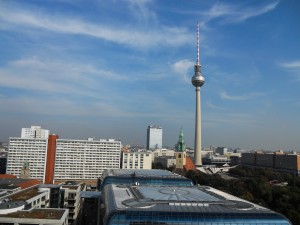 This was the first place in Berlin where I could feel the energy of the city. Live music, literal carnival rides, Trams begging for the opportunity to turn you into a statistic, Döner kebap and Currywurst stands everywhere, and even people bungee jumping off of skyscrapers; it was surreal. Luckily, Alexanderplatz is a main transit junction and I was able to explore this area multiple times. <George DeRosa ‘16>
This was the first place in Berlin where I could feel the energy of the city. Live music, literal carnival rides, Trams begging for the opportunity to turn you into a statistic, Döner kebap and Currywurst stands everywhere, and even people bungee jumping off of skyscrapers; it was surreal. Luckily, Alexanderplatz is a main transit junction and I was able to explore this area multiple times. <George DeRosa ‘16>
Brandenburger Tor
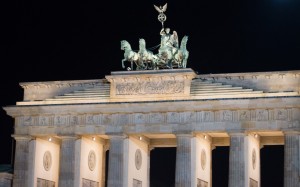 A symbol reminding us of Germany and Europe’s checkered past and also a symbol for peace. It’s very impressive to see at night.
A symbol reminding us of Germany and Europe’s checkered past and also a symbol for peace. It’s very impressive to see at night.
<George DeRosa ‘16>
I went to multiple Flohmärkte (flee markets) and art markets around the city. They were very interesting for what they were, but mostly because of the sheer number of people that were attending them. My favorites were easily the markets on Museum Island. It’s a very good place to buy books if you want to practice your reading in German! <Katie Mooradian ‘16>
The entire trip was filled with poignant moments of history and cultural difference (especially for me, after being raised in a small town). If I had to select a theme, or a feeling, that struck me throughout the weekend, I would choose the very strong difference between Germany’s and America’s history that could be felt throughout the city. It is easy to take for granted over 200 years of consistent and constant govern- ment. Since the creation of the first German empire in 1871 there hasn’t been a regime that has lasted more than about 50 years. The fall of the Wall was only 25 years ago. The reminders of this unrest, as well as the hope for a steadier time, could be found throughout the entire weekend. From the discussions in the conference, to visiting the Berlin Wall and East Side Gallery, to seeing the ancient Babylonian temple in the Pergamon Museum, to celebrating German Re-Unification Day, Berlin serves as a symbol of different pieces being brought together. The old murals on the Berlin Wall are painted with fresh graffiti, old cathedrals look at a giant TV tower built during the time of East Germany and Berlin, and flea markets are filled with used DVDs and old maps from around the world. <Rachel Schilling ‘16>
Berlin is without a doubt one of the “must visit” cities in Europe. It is densely loaded with history, culture, diversity, liveliness and fun. I was particularly attracted to the aesthetic and artistic displays the city, which are like a timeless collage of different styles. Some great examples of this are the graffiti on the streets, the galleries in the open air such as East Side Gallery, the different architectures in the different neighborhoods and especially between the East and the West and the sudden remnants of older periods such as the Berliner Dom. To finish the recipe there are many modern places such as bars, coffee shops, clubs, restaurants and malls all around the city. Berlin is an incredibly mixed city, but it still keeps a bohemian scent to it, for which I think that it really lives up to the “poor, but sexy” slogan that Klaus Wowereit coined in 2004. <Santiago Princ ‘16>
Transatlantic Conference in Berlin
The Enigma of Freedom – A Transatlantic Conference on the Significance of Heiner Müller for the 21st Century at the Day of German Unity, October 3-5, 2014
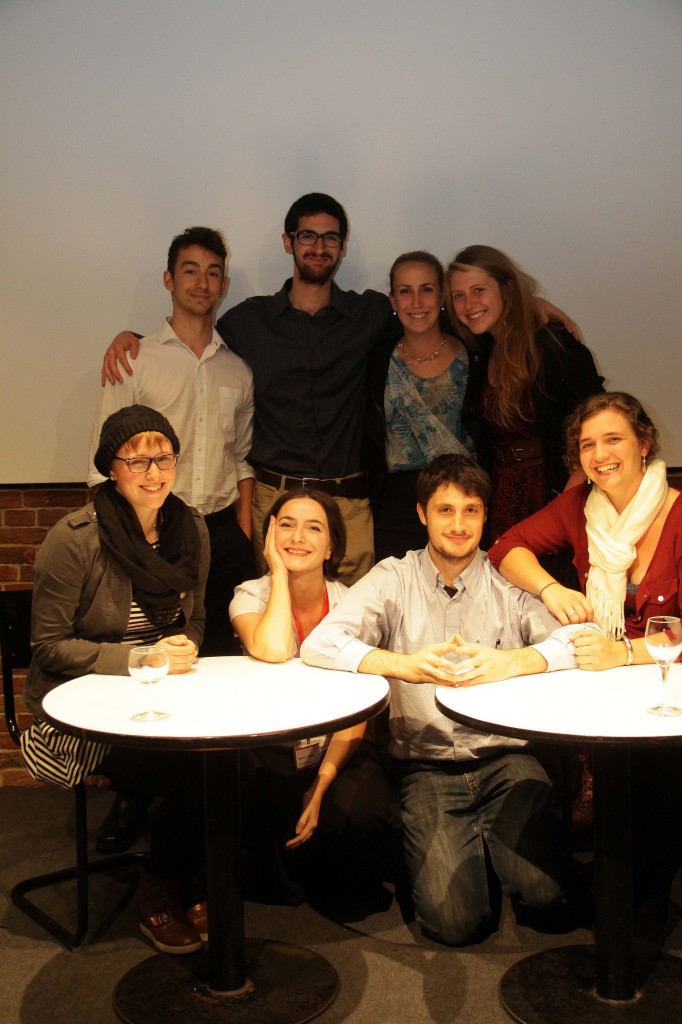
Adrienne, J. Ludwig, Ezra, Rachel (front, from left to right), Santiago, George, Cassie, Katie (back row) ©: Uwe Fechner
The Dickinson students currently on their year abroad at the University of Bremen had a unique opportunity to experience German culture and recent history from an exceptional angle. On a five-day excursion to Berlin, they not only explored historical and cultural sites such as the Brandenburg Gate or the Reichstag.
They also attended a conference on one of the most influential cultural figures of 20th century Germany: the playwright Heiner Müller. It had been co-organized by the Academic Director of the Durden Bremen Program, Janine Ludwig, together with Anja Quickert and Florian Becker on behalf of the International Heiner Müller Society.
At the conference, the students could hear and meet many important German (and American) intellectuals – among them:
 Gregor Gysi (parliamentary party leader of “The Left”), Jens Reich (molecular biologist, GDR civil rights activist and former candidate for the German Presidency), Thomas Martin (chief dramaturg of Berlin’s celebrated avant-garde theater “Volksbühne”), Wolfgang Engler (rector of Germany’s most prominent acting school „Ernst Busch“), Hermann Beyer (long-time actor at the legendary Brecht theater “Berliner Ensemble”), Ivica Buljan (head of the Zagreb International Theatre Festival), David Levine (US-American performance artist, Bard College Berlin), Jost Hermand (renowned literary scholar at the University of Wisconsin-Madison), B.K. Tragelehn (director, one of the last living master students of Bertolt Brecht’s, and long-time friend of Müller’s) – and many more.
Gregor Gysi (parliamentary party leader of “The Left”), Jens Reich (molecular biologist, GDR civil rights activist and former candidate for the German Presidency), Thomas Martin (chief dramaturg of Berlin’s celebrated avant-garde theater “Volksbühne”), Wolfgang Engler (rector of Germany’s most prominent acting school „Ernst Busch“), Hermann Beyer (long-time actor at the legendary Brecht theater “Berliner Ensemble”), Ivica Buljan (head of the Zagreb International Theatre Festival), David Levine (US-American performance artist, Bard College Berlin), Jost Hermand (renowned literary scholar at the University of Wisconsin-Madison), B.K. Tragelehn (director, one of the last living master students of Bertolt Brecht’s, and long-time friend of Müller’s) – and many more.
Find the program flyer attached: IHMG HM-Konferenz Programm-Leporello
Here is what the students said:
I had two favorite parts of the Müller conference. The first was the “Table Talks” during the second afternoon of the conference where the conference goers had the chance to sit and speak with people who were close with Müller both on and off the stage. These “Table Talks” broke the invisible wall between the audience and the presenters and allowed for more questions to be asked and discussions to be had. My other favorite part of the conference was one of the last panels where theater directors from different Eastern European countries compared and contrasted the reception and implementation of Müller’s works in two very different social environments.
— A particular memorable moment for me was when a pair of presenters began to discuss the DEFA and its role in film production in East Germany. This caused me to reflect back on my previous research on the DEFA and actually helped me formulate an idea for my senior thesis in German for next year! Another just generally cool moment was when the group was approached during one of the breaks by a woman who is staging a production of one of Müller’s plays not far from Bremen and invited us as a group to come watch the show and meet the actors. <Rachel Schilling ’16>
Before attending this conference I didn’t know who Heiner Müller was. Now I have a more complete understanding of why he is considered the most important German playwright of the second half of the 20th century. During the conference I was able to speak with one of the last living students of Bertolt Brecht and hear personal stories about Müller and Brecht himself. The event was very well organized and I am thankful that I was able to attend not only this conference but explore the city of Berlin itself. <George DeRosa ‘16>
My favorite part of the conference was a panel which included a philosopher, a cultural journalist, and a dramatic advisor, each of whom had a personal connection with the playwright. I saw right from the beginning the wide variety of people Heiner Müller’s work had influenced. It interested me that the work of a single man could carry so much meaning for three people of such differing professions.
— One of the activities at the conference were Tischgespräche or “Table-Talks,” where audience members could sit on comfortable couches around people who had known Heiner Müller personally and hear stories from time they had shared together. The table I went to included Alexander Weigel, a dramaturg who worked with Müller on two of his plays, “Der Lohndrücker” and “Hamlet/Maschine.” I was especially struck by the stories where Weigel explained the tensions in Hamlet/Maschine between trying to create a political commentary in the play and trying to keep the themes in Hamlet alive. Weigel remembered that Müller said to him: “Shakespeare ist wichtiger als die DDR” or “Shakespeare is more important than the German Democratic Republic.”
— One thing I focused on was expanding my German vocabulary and knowledge of German word-genders, a topic which has always plagued my ability to speak German fluently and confidently. Although my focus and interest in learning German places less emphasis on literature and drama, at the conference I was still able to listen for much information of personal interest. For example, because of the wide variety of the fields of presenters, I learned many German words and expressions which I had not heard before. I also listened for different German dialects (another area of personal interest) among the presenters, as some spoke with a “Berliner” accent. <Ezra Sassaman ’16>
I’m not sure that I have ever heard of Müller before this conference, which is frankly quite embarrassing because he is apparently labeled the second most important German dramatist of the 20th century after Bertolt Brecht. I have a relatively limited knowledge of German history, but this conference helped me to understand what it was like to be an artist working in the GDR. For instance many of Müller’s plays were not allowed to premier or were censored after only one screening. Nonetheless he continued to gain popularity in the West and internationally. Many of his plays were staged in Western Germany, and even his controversial Mauser was shown for the first time in Austin, Texas. By the 1980s, the GDR welcomed Müller again because of his international fame.
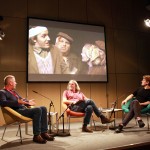
“BLABLA” Panel: Ivica Buljan, Thomas Irmer, Wojtek Klemm (fr. l. t. r.) © all following pictures: Uwe Fechner
My favorite part of the conference was the “BLABLA” section on Sunday because I finally got to see some of Müller’s work on stage. I did not realize how provocative his postmodernist style was until I had seen it. I was honestly surprised the GDR ever decided to support him, regardless of his fame.
— The table talks were a very interesting and unusual addition to the conference. It allowed me to sit and talk with a close friend of Müller’s, B.K. Tragelehn and his wife, and hear about Müller in his youth. He shared many intriguing stories from their youth and told us about Müller’s personal life from an insider’s view.
— Although it was hard to follow the panel “Was jetzt passiert, ist die totale Besetzung mit Gegenwart” I found this one quote extremely interesting. I’m not sure if it came from Müller, or one of the presenters, but nonetheless it got me thinking. “Socialism leads to individualism, capitalism leads to collectivism.” I really enjoyed being exposed to so many German and international intellectuals and expanding my German and cultural knowledge. It was also very helpful to hear high level academic German before beginning our schooling at the University. <Katie Mooradian ’16>
The conference consisted of very complex and very dense information given all in German all at once. That being said I look at it similar to sports. You don’t get better playing teams on your level, only by playing teams that are better than you, and even though you are getting beat you are learning and increasing your knowledge for the future. Same goes for this conference, the language used and topic were more complex and difficult than the level I was at, but in the end I do feel like I got something out of being there and focusing on trying to understand what the speakers were saying. My favorite part was the table talk where you could go and speak to some of the speakers and other people connected to Heiner Müller. I listened to B.K. Tragelehn and his wife speak and the stories they told were so interesting, and it gave a more personal outlook into Heiner Mueller’s life. I think that was easier for me to understand because it was a more focused group of people with him just talking to 5 or 6 of us. I really did enjoy the table talk immensely. <Cassie Blyler ‘16>
One of the conference panels which I enjoyed the most was the “Tischgespräche mit Zeitgenossen,” which was held on the second day of the conference. This panel had a very flexible and informal approach. The speakers scattered over small coffee tables so all of us could engage them on a more personal level. I joined a conversation with B. K. Tragelehn, a renowned director, author, translator and former student of Bertolt Brecht and friend of Heiner Müller. During the panel, Mr. Tragelehn shared many of his amazingly rich experiences as a student, coworker and independent author as well as some personal insights about Bertolt Brecht, Heiner Müller and his wife Inge Müller. Although my fields of study are unrelated to either theater or literature, getting such a rare opportunity to meet one of the last people who studied and worked with such important characters of history and culture was indeed an amazing experience.
I must say that I was surprised by the wide variety and high caliber of the conference’s guests, which included artist, representatives from literature institutes, widely renowned politicians, academics from all over the world and authors who had the privilege of working side by side with the most important theater personalities of the 20th century and who underwent the whole social and institutional revolution that came with the fall of the Wall. Unfortunately, I did not get to talk to all of them, but I did get to hear what some of the greatest minds on the theater and literature scene think. The conference also bore unexpected fruits as we got to meet a woman who happened to be involved in the management of a theater in Osnabrück and that offered us (all the members of the Bremen program) to attend one the Heiner Müller’s plays that were being performed there.
— Academically, the conference was a challenging experience. To begin with, most of the panels were in German, so they required lots of concentration and some effort in order to keep up and decipher some of the most complex opinions. Historically and culturally speaking, the conference covered a wide variety of topics. The whole scene of German theater and literature was affected by the geopolitical and socioeconomic changes that happened in Germany throughout and after the Cold War and the fall of the wall. Therefore, there was always a very complex background to keep in mind in order to fully understand some of the discussions regarding the importance and the repercussions of Heiner Müller’s work in Germany and nearby countries. I personally felt that every minute of the conference was loaded with information and that it required a lot of thinking to keep up. <Santiago Princ ‘16>
The conference which was supported by Dickinson and Bard College gave me an interesting look into what culture was inside the DDR and in other communist ruled areas of Eastern Europe. Due to the fact that the academic style of German went a little over my head, I gained the most insight from the last session we attended which was held in English. It was comparing the cultural reception of Heiner Müller’s works in Poland and former Yugoslavia. Having gone to another conference this summer about German authors in Poland at the time of its separation from Germany, I enjoyed the extra insights to Polish history and culture. <Adrienne Brown ’16>
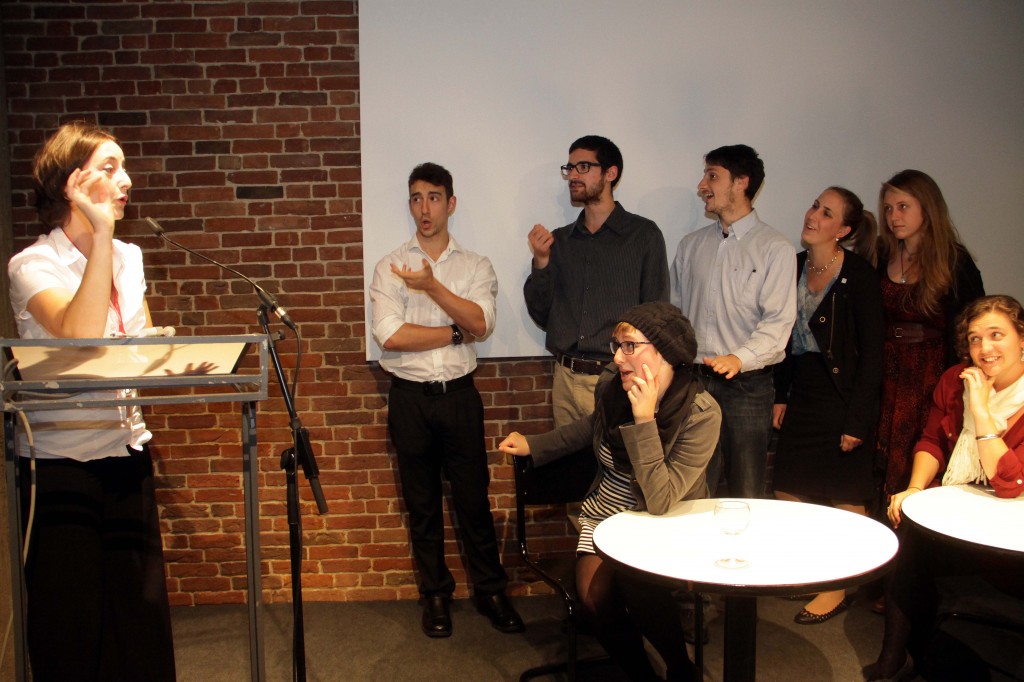
Students are jokingly re-enacting a scene which they just saw in a documentary film about Heiner Müller, made by Thomas Heise. In it, Müller and the famous director Fritz Marquardt were telling actors several times precisely and meticulously how to pronounce a single word (king) in a sentence from Müller’s play “Germania Death in Berlin”: „Will er nicht aufstehen vor seinem König?” (Does he not want to stand up before his King?). In the front, from left to right: Janine Ludwig, Adrienne Brown, Rachel Schilling. From left to right in the back row: Santiago Princ, George DeRosa, Ezra Sassaman, Cassandra Blyler, Katherine Mooradian
What colleagues say:
 I think the students appreciated the historically rich venues like the Academy of the Arts in East and West Berlin, on both sides of the once-divided city which is not just the
I think the students appreciated the historically rich venues like the Academy of the Arts in East and West Berlin, on both sides of the once-divided city which is not just the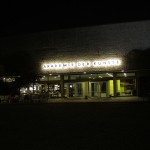 political Capital of Germany, but the cultural capital as well. By embedding the conference into a Berlin excursion, I was hoping to enable them to connect their adventures in the historic city and in its current cultural scene with the contents of this conference.
political Capital of Germany, but the cultural capital as well. By embedding the conference into a Berlin excursion, I was hoping to enable them to connect their adventures in the historic city and in its current cultural scene with the contents of this conference.Bremerhaven Auswandererhaus
Last month I had the pleasure of visiting the “Auswandererhaus” (Emigration House) in Bremerhaven. It is a museum which focuses on the emigration of Germans to other countries throughout history. I really enjoyed the set up of the museum. There were many models which showed, for instance, how the harbor looked at various times and the different types of ships people traveled on. The first large room was made to look like the harbor with mannequins dressed to look like emigrants from various time periods and social classes. I really enjoyed how they showed examples of what people packed to bring with them. It was shockingly little, but I think it says a lot about a person, what few personal belongings they bring along to their new life.
In the second room you could hear personal stories about families or individuals. Much of the information was gathered from letters they wrote to loved ones or personal journals. There were also display cases which explained the main reasons why Germans were leaving their country during various time periods. In the time from 1871-1913 most emigration was from poorer classes who wanted to move up in society. From 1914-1918 the main reasons for emigration were the depression after WWI, inflation, and lack of work. In the years during and directly after WWII, many of the people who emigrated were political or Jewish refugees trying to escape persecution by the Third Reich. These are just a few examples, but I found it very interesting to see how peoples’ reasons for leaving their homeland changed throughout history.
The next section of the museum was my favorite. They replicated some of the living situations that passengers on different types of ships would have lived in. I am always surprised at how deplorable the living situations were for emigrants with little money, and just how long they needed to be living this way. The difference between the 3rd class and 1st class was actually disgusting.
I particularly liked this one map that showed the U.S. and in each state is said which country the majority of citizens had descended from. I liked this because you could see how the culture of the country were the most people immigrated from still shapes the culture of that area today. For instance New York is especially known for their pizza, and by no coincidence the most people who immigrated there were Italians. Whereas in Pennsylvania the largest immigrant group was German, and there is still a large Amish population which have roots in Germany.
After visiting the museum I had the pleasure of visiting the Bremerhaven Christmas market, which I must admit was not as impressive as Bremen’s but still very fun!
Katie Mooradian ’16




